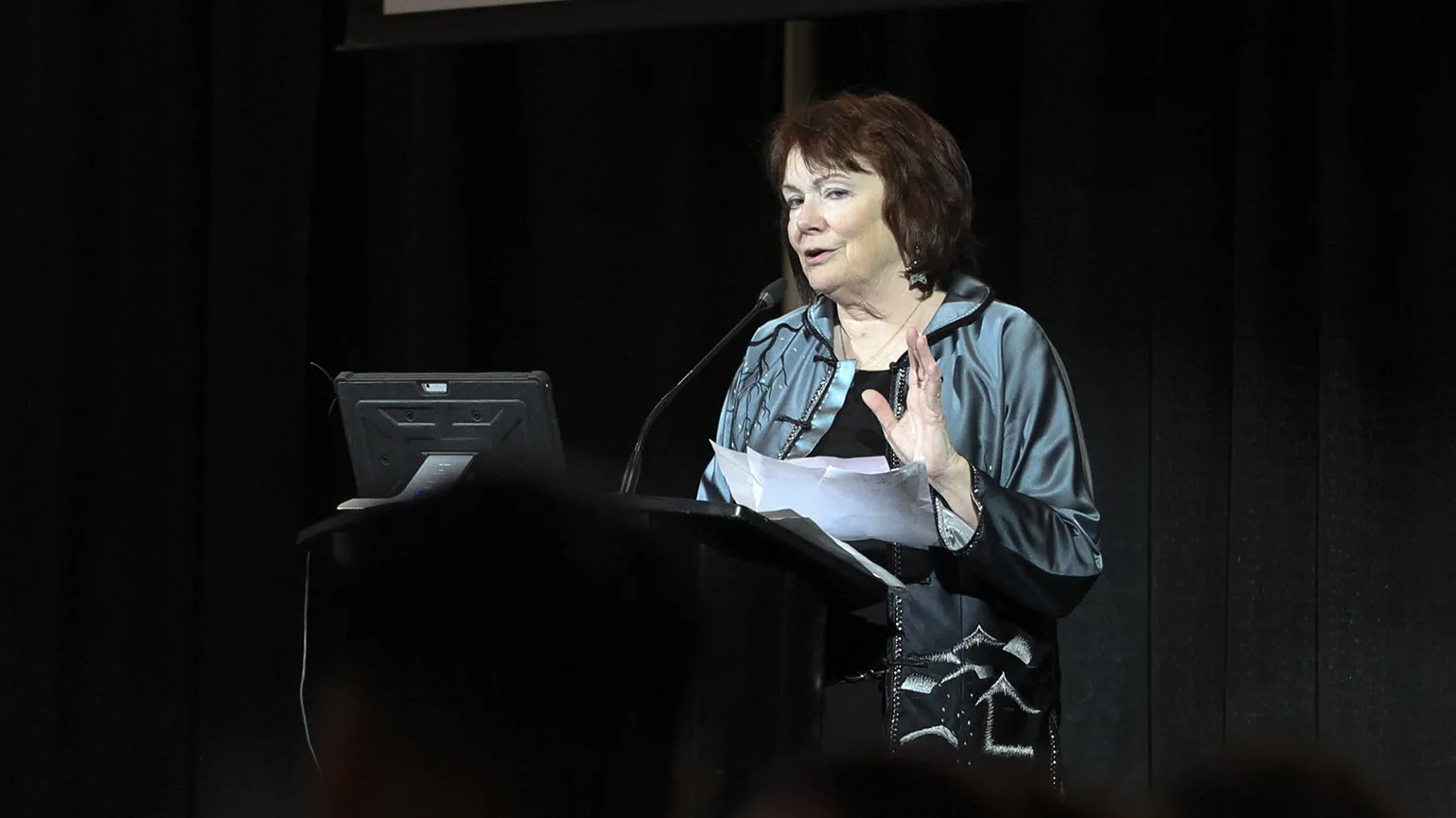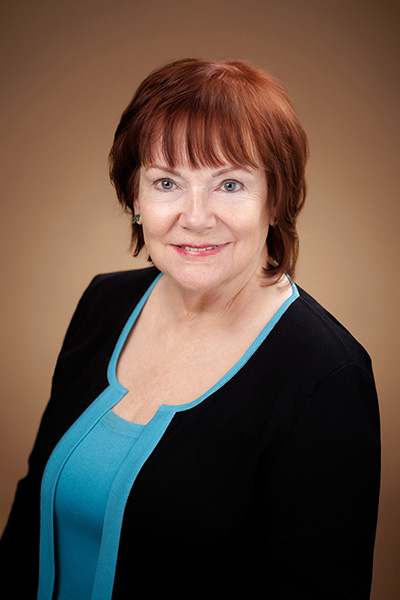Joe Gutierrez | Office of Strategic Communication | (909) 537-3007 | joeg@csusb.edu

Mary Anne Schultz, who retired from the Cal State San Bernardino Department of Nursing and currently serves as a lecturer in the department, will be formally inducted into the American Academy of Nursing (AAN) as a Fellow on Saturday, Oct. 29.
Schultz, who has been teaching for 30 years and has been a nurse for 47 years, will join more than 100 other inductees nationwide, who will be formally recognized for their significant contributions to health and health care during the AAN’s annual Health Policy Conference in Washington, D.C. This year’s conference theme is “From Reflection to Impact: Positioning Nursing’s Future.”
“The fellowship is an opportunity to serve the academy and the profession, including the global profession, further, by advancing scholarship, research and political advocacy for nursing issues,” said Schultz. “Some consider it a lifetime achievement award, but it’s really about impact. It is so different from other awards a faculty or a distinguished nurse might get. It’s not about a list of achievements, it’s about the reach of your work in global health.”

Schultz said her focus is within the specific intersection of innovation and science such as Precision Health, which according to UCLA Health, takes into account differences in people’s genes, environments and lifestyles when formulating treatment and prevention strategies based on patients’ unique backgrounds and conditions.
She currently serves in the Advisory to California’s Initiative to Advance Precision Medicine (CIAPM), a statewide council of health professionals, scientists and community activists that she was appointed to by Gov. Gavin Newsom in 2020. Schultz, who is also an informaticist, serves as the sole registered nurse on the 11-member advisory council, which will support patient-focused research demonstration projects and connect health and medicine stakeholders across the state.
Within the CIAPM, Schultz serves as a Data Integration Workgroup member, bringing a nursing voice to such matters as facilitating the use of Electronic Health Records (EHRs) by researchers and, more fundamentally, defining Social Determinants of Health (SoDH).
She said she has always in some way been involved in the impact of technology on nursing practice and its subsequent impact on patient outcomes.
“The technology is included under how an organization is structured, how many nurses credentialing, how are they trained and prepared, and physicians as well,” she said. “Those are the structural characteristics of an organization that matter to inpatient outcomes. Moving beyond technology per se, the electronic health record and the massive amount of data that’s available.”
This transforms the patient encounter from reactive to predictive and involves the use of “Big Data,” which she called the Niagara Falls of data on a person’s health. Every piece of data – from blood pressure and blood sugar levels measured while hospitalized to every height and weight from primary care settings to anything that comes out of a watch or wearable such as the number of steps a person takes to data about their environment – all of this can be used for highly individualized care known as Precision Health.
“We’re predicting everything these days with AI and ML. Even a sensor that’s in your ear can reconstruct the architecture of the inner ear and tell us about balance and orthopedic needs. It can tell us about core body temperature, a fever that’s on its way,” Schultz said. “So other harbingers of disease or disability just from a device that’s worn in your inner ear or perhaps other wearables, by extension, has a lot of predictive power in an illness event, a serious hospitalization, or death.
“So there’s a great case with Big Data to be made for prevention, really meaningful, primary prevention, and not the care that you and I have known, which is the episodic, fragmented and after the fact. Reactive care – get sick, seek a remedy. We’re going to be really predicting now and partnering with patients better to prevent the heart attack or its severity once it arrives, to prevent the attack of appendicitis or lessen its severity once it arrives,” she said.
Schultz said she became interested in nursing as she wanted to help people.
“The values I was raised on in Youngstown, Ohio, with parents of the era of the Great Depression and World War II, who taught us the world would be a better place if you did your job right and well. And it’s a service profession that made a decent living. So those things attracted me,” she said.
And technology in health care fascinated her early on.
“I was an early employee of intensive care units. They were underway a good 10 or more years by the time I became a nurse. But they weren’t all that well developed. And then the intensive care units became increasingly sophisticated in the time I’ve been a nurse to where you held a patient’s life in your hands, literally, by altering their blood pressure and their fluid balance, in cardiac care situations,” she said. “I mean, you literally had their life in your hands with technology and sustained their core body functions with lifesaving equipment, and some of the equipment and principles are true to this very day. And then Big Data came along. Then AI and ML came along about a decade ago to analyze that gigantic amount of data.”
As a nursing instructor and administrator, she worked with other faculty to focus on Precision Health.
“When I was a department chair, various committees began to discuss precision health. I encouraged it, and we now have precision health as a thread throughout our curriculum, and that’s pretty unusual for a department of nursing to have done that already.” Schultz said. “We adopted precision health principles such as highly individualized care that’s based on your data, care that is not reactive but predictive, in order to help students understand what AI and machine learning means in health care.
“That work has been published and presented in professional meetings, and we’re just real proud of it. Real proud of it,” she said.
“The fellowship is an opportunity to serve the academy and the profession, including the global profession, further, by advancing scholarship, research and political advocacy for nursing issues. Some consider it a lifetime achievement award, but it’s really about impact. It is so different from other awards a faculty or a distinguished nurse might get. It’s not about a list of achievements, it’s about the reach of your work in global health.”
Mary Ann Schultz
Schultz joins approximately 2,900 other American Academy of Nursing Fellows, who are nursing leaders in education, management, practice and research. Fellows are found working as association executives; university presidents, chancellors and deans; elected officials; state and federal political appointees; hospital chief executives and vice presidents for nursing; nurse consultants; and researchers and entrepreneurs.
According to their website, invitation to fellowship is more than recognition of one’s accomplishments within the nursing profession. Academy Fellows also have a responsibility to contribute their time and energies to the Academy, and to engage with other health care leaders outside the Academy in transforming America’s health system by:
- Enhancing the quality of health and nursing;
- Promoting healthy aging and human development across the life continuum;
- Reducing health disparities and inequalities;
- Shaping healthy behaviors and environments;
- Integrating mental and physical health; and
- Strengthening the nursing and health delivery system, nationally, and internationally.